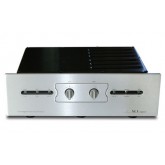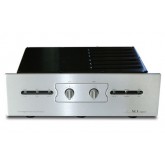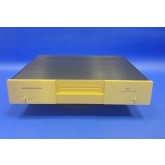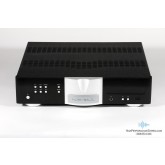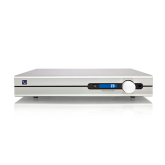Preamplifiers
-
Convergent Audio Technology SL1 Legend/ BLACK PATH EDITION with Phono
The SL1 Legend takes this uncompromising approach further than the product with which Ken literally started the company, the SL1 preamp, now in its Renaissance version. The two use essentially the same circuit, but in the case of the Legend that circuit is taken to the extreme -- it's a cost-no-object implementation. On the outside, the two look nearly identical, but there are a couple of notable differences. Chief among these is the use of dual volume controls in the Legend instead of separate volume and balance. Both preamps use stepped volume controls, essentially a set of resistors for each setting, but the Legend's 46-position shunt volume controls are more costly than those used for the standard SL1, whose fewer positions cause issues for some owners, as the perfect volume setting can sometimes lie between two "clicks." Not with the Legend; 46 positions should be enough for even the pickiest listeners. Learn More -
Convergent Audio Technology SL1L Legend/ BLACK PATH EDITION w/o Phono
The SL1 Legend takes this uncompromising approach further than the product with which Ken literally started the company, the SL1 preamp, now in its Renaissance version. The two use essentially the same circuit, but in the case of the Legend that circuit is taken to the extreme -- it's a cost-no-object implementation. On the outside, the two look nearly identical, but there are a couple of notable differences. Chief among these is the use of dual volume controls in the Legend instead of separate volume and balance. Both preamps use stepped volume controls, essentially a set of resistors for each setting, but the Legend's 46-position shunt volume controls are more costly than those used for the standard SL1, whose fewer positions cause issues for some owners, as the perfect volume setting can sometimes lie between two "clicks." Not with the Legend; 46 positions should be enough for even the pickiest listeners. This item is without phono Learn More -
Conrad Johnson TEA1 S3 Phono-Stage
TEA1 Series 3 Phono Preamplifier The TEA1 Series 3 triode equalization amplifier is a stand-alone vacuum-tube phono stage designed to satisfy the expectations of the most demanding music lovers. The TEA1s3 features a zero loop feedback circuit with passive RIAA equalization. It offers two phono inputs, one with switch selectable resistive and capacitive loading allowing the user to fine-tune performance to the chosen phono cartridge. The other input is fitted with premium wide-bandwidth audio transformers installed on the PHONO 1 input to provide the higher gain and very low noise required by low output moving coil cartridges. Designed to precisely track the prescribed RIAA equalization curve, the TEA-1s3 assures absolute tonal accuracy. The low-gain audio circuit of the TEA-1s3 is comprised of two cascaded single-ended triode amplifiers. The circuit is a zero-feedback design, to eliminate the temporal inaccuracies that negative feedback introduces. RIAA equalization is established by a passive network between the two gain stages. Careful implementation of this fundamentally simple circuit results in extremely wide bandwidth and low distortion, without resorting to negative feedback. The ideal dc power supply circuit is simply a zero impedance path to ground. Any deviation from this ideal is fully reflected in the audio circuits. Thus the power supplies are as important to audio performance as the audio circuits and must be accorded equal attention in design. In the TEA-1s3, each stage has its own discrete regulated DC power supply. These power supplies have been carefully designed for minimum impedance, even at the highest audio frequencies, to prevent the power supplies from degrading music reproduction. The TEA1s3 is optionally available as the TEA1s3b with the step-up transformers deleted. This version of the TEA1s3 has two direct inputs, one with variable loading and one with fixed loading. The full potential of any circuit design can only be realized if executed with the highest quality parts. The audio circuits of the TEA-1s3 use only conrad-johnson’s proprietary Teflon capacitors. In the power supplies, all capacitors are polypropylene or Teflon – there are no electrolytic capacitors anywhere in the audio circuits or their dc power supplies. The audio circuits and related power supplies both use high-precision laser trimmed metal-foil resistors, designed for ultra-low inductance. All parts in the RIAA compensation network are 1% tolerance, to assure precise tracking of the RIAA curve. Input and output connectors are gold-plated, machined oxygen free copper. Even the hookup wiring has been carefully selected for optimal audio performance. The casework features black anodized aluminum, brushed-polished, sides and ventilated top cover. Thoughtful engineering, specification of the finest available component parts, and painstaking care taken in production make the TEA-1s3 a phono equalization preamplifier without peer in music reproduction. We invite you to arrange an audition with your conrad-johnson dealer to confirm for yourself the extraordinary musical performance of these products. Learn More -
Conrad Johnson ET7 S2 line stage, vacuum-tube
Excellent condition, all packing. We are CJ dealers ET7-S2 Enhanced-Triode Preamplifier The ET7-S2 enhance triode line-stage preamplifier has been designed to incorporate the advances made with the Series 2 upgrade to our flagship GAT into a more affordable model. The circuitry of the ET7-S2 follows closely that of the GAT Series 2. The audio circuit is elegant in its simplicity. An audio amplifier stage consisting of a single-ended triode amplifier provides the voltage gain. This amplifier stage is connected to the preamplifier outputs through a high-current MOSFET buffer, which achieves a very low output impedance, making the ET7-S2 extremely flexible in the choice of interconnect cables and amplifiers. DC voltage is supplied to the circuit by the revised discrete voltage regulator developed for the GAT Series 2. It isolates the audio circuit from the power line by maintaining negligible impedance across the audio frequency band. Infra-sonic noise is minimized by operating the tube filaments (heaters) on a dc voltage supplied by a separate regulated power supply. The ET7-S2 also boasts the GAT’s convenience and ease of use. The unit features input selection and level adjustment by microprocessor-controlled relays, with controls available both at the front panel and via a full-function remote. All control functions of the ET7-S2 operate through microprocessor-controlled relays. For the level control, the relays select combinations from a network of precision, low-noise metal foil resistors to effect loudness and balance changes in 100 steps of approximately .7dB per step. All switching and adjustment can be controlled by the unit’s remote control. A Theater Mode, which passes the input signal through at unity gain, makes it simple to incorporate the ET7-S2 into a high quality home theater system without compromising its two-channel performance. Like its bigger brother, the GAT Series 2, the ET7-S2 is constructed from the highest quality, carefully selected parts for unrivaled sonic performance and reliability. Tubes have been selected for minimum noise and microphonics. CJD Teflon capacitors are used in the ET7-S2 for output coupling and post-regulator power supply storage. In the power supplies, all capacitors are of polypropylene or Teflon—there are no electrolytic capacitors anywhere in the audio circuits or their DC power supplies. The resistors in these circuits (including the two dozen level control resistors) are special low inductance, high-precision laser-trimmed metal foil resistors. Switches are sealed relays with gold-plated silver contacts. Input and output connectors are machined from oxygen-free copper, and are gold plated. For four decades, the conrad-johnson design team has been dedicated to creating audio components that do credit to music performances. Through meticulous engineering, careful specification of only the finest available component parts, and a painstaking attention to construction, we have created what we feel is a line-stage without rival in its class. We invite you to arrange an audition of the ET7-S2 with your conrad-johnson dealer to experience the extraordinary musical performance of this remarkable preamplifier. Learn More -
Conrad Johnson ET6SE with SE phono stage, vacuum-tube
ET6/ET6SE Vacuum Tube Preamplifiers At conrad-johnson, development of our flagship products has traditionally led to important enhancements of our entry-level offerings. The ET6 preamplifier is a case in point. The ET6 line-stage is a “baby” version of our flagship line-stage preamplifier, the GAT. The family resemblance is much more than skin deep. With voltage gain provided by a triode vacuum-tube, the zero-feedback line-stage circuit of the ET6, along with its DC voltage regulators, closely replicates the circuit of the GAT. Finally, and especially noteworthy, the ET6 features a relay operated discrete stepped attenuator level-control circuit of the type found in the GAT and ET7, absent only the balance control function found in those more costly models. Functionally, the ET6 provides highly flexible I/O facilities with six separate line-level inputs (including one “tape” loop), plus a theater loop that facilitates use in a home theater system. In addition, the ET6 offers the convenience of infrared remote control of all functions. For vinyl enthusiasts, the ET6 is optionally available with a vacuum-tube phono stage that borrows its zero-feedback audio circuit from our reference quality TEA1-S3 phono stage. Customers can choose between high gain (recommended for cartridges with a rated output of 1.0 mV or less) and low gain (recommended for cartridges with rated output greater than 1.0 mV) versions of the phono stage. Input resistive loading is switch selectable over a range from 47 kOhms down to 200 Ohms. The ET6 phono stage is built to the same high quality standard found in the ET6 line-stage. Premium quality component parts are specified to optimize performance and to sustain that performance for years to come. Precision, metal-film resistors yield low noise performance for greatest clarity. Polypropylene capacitors, used exclusively in the audio circuits and the regulated plate voltage supplies, offer extraordinary temporal accuracy. In fact, the ET6 is built to standards that meet or exceed those of many companies’ “flagship” offerings. Those who wish to take the performance to yet a higher level will be thrilled by the availability of an upgraded “SE” version. The ET6SE boasts CJD Teflon capacitors and metal foil resistors in critical circuit applications. It would be fair to say that the only thing “entry-level” about the ET6 is its price. Arrange to audition one at a conrad-johnson dealer to find out for yourself – you’ll be surprised at just how affordable true high-end performance can be. Learn More -
Conrad Johnson ET6 with phono stage, vacuum-tube
For vinyl enthusiasts, the ET6 is optionally available with a vacuum-tube phono stage that borrows its zero-feedback audio circuit from our reference quality TEA1-S3 phono stage. Customers can choose between high gain (recommended for cartridges with a rated output of 1.0 mV or less) and low gain (recommended for cartridges with rated output greater than 1.0 mV) versions of the phono stage. Input resistive loading is switch selectable over a range from 47 kOhms down to 200 Ohms. The ET6 phono stage is built to the same high quality standard found in the ET6 line-stage. ET6 Optional Phono Stage•High Gain Version 54dB •Low Gain Version 40dB •RIAA Equalization: +/- .25 db 20Hz to 20kHz •Hum and Noise: -80dB relative to 10mV input •Phase: phase correct •Tube Compliment: High Gain Version 3x 12AX7 Low Gain Version 2x 12AX7, 1x 12AU7 Learn More -
Krell Illusion II Preamp and DAC
Krell Illusion II, like new condition, complete with box and all accessories retail 1/22 is $9400 Analog Inputs 2 pr. balanced via XLR connectors 3 pr. singleended via RCA connectors Digital Inputs 1 AES/EBU via XLR connector 2 coaxial via RCA connectors 2 optical via Toslink connectors Main outputs 1 balanced via XLR connectors 1 pr. single]ended via RCA connectors Download the "Quick Set-up Guide" Headphone output 1 via 3-conductor 6.35 mm (1/4 inch) connector Control inputs 1 RS-232 input via a 9-pin D-subminiature connector 1 remote IR detector input via a 3-conductor 3.5 mm connector 1 12 VDC trigger input via 2-conductor 3.5 mm connector Control outputs 2 individually programmable 12 VDC trigger outputs via 2-conductor 3.5mm connectors (30 mA maximum per output) Learn More -
Conrad Johnson ET6 Linestage, vacuum-tube
ET6/ET6SE Vacuum Tube Preamplifiers At conrad-johnson, development of our flagship products has traditionally led to important enhancements of our entry-level offerings. The ET6 preamplifier is a case in point. The ET6 line-stage is a “baby” version of our flagship line-stage preamplifier, the GAT. The family resemblance is much more than skin deep. With voltage gain provided by a triode vacuum-tube, the zero-feedback line-stage circuit of the ET6, along with its DC voltage regulators, closely replicates the circuit of the GAT. Finally, and especially noteworthy, the ET6 features a relay operated discrete stepped attenuator level-control circuit of the type found in the GAT and ET7, absent only the balance control function found in those more costly models. Functionally, the ET6 provides highly flexible I/O facilities with six separate line-level inputs (including one “tape” loop), plus a theater loop that facilitates use in a home theater system. In addition, the ET6 offers the convenience of infrared remote control of all functions. Learn More -
Conrad Johnson ET6PHSE phono card
Price is for phono card when ordered with the ET3. When purchased for installation in an existing unit, there is a 2 hour labor charge for installation. Learn More -
PS Audio Stellar Gain Cell DAC Full featured DAC and analog preamplifier FREE SHIP!
PS Audio Stellar Gain Cell DAC Full featured DAC and analog preamplifier Only one silver and two black left as of 4/26/21 he Gain Cell DAC will transform your expectations of what’s possible in an under $2,000 DAC. Based on an improved version of our NuWave DSD, the performance of the Gain Cell DAC is unparalleled in this price category, or anywhere near. The Gain Cell DAC produces a seamless 3D soundstage from even normal CDs. Labored over by its chief architect, Bob Stadtherr, and hand-tuned and voiced by Paul McGowan and Darren Myers, the improvement in sound quality over other DACs is astonishing. The Gain Cell DAC accepts inputs from any digital source including I²S and USB from your computer and outputs directly through Stellar’s analog Gain Cell preamplifier with either single ended (RCA) or balanced (XLR) connections. Used with music server software like JRiver, Bit Perfect, Amarra or Pure Music and an iPhone or Android app, the Gain Cell DAC becomes your entry into the world of high-end digital audio music, both PCM and DSD. Performance is superb at anywhere near the price and there are good reasons why, as you’ll soon discover. In fact, the Gain Cell DAC is one of the best sounding products we have produced in our 24 years of building DACs. Sweet, spacious and effortless, this device will bring the life back into your music and all at the touch of a finger. Digital Lens inside All input signals are taken into the Gain Cell DAC in Native Mode, without Sample Rate Conversion (SRC) and fed directly into a simplified FPGA known as a CPLD (Complex Programmable Logic Device), which discovers sample rate and format, reclocks all incoming data, reduces jitter, waveshapes data output to the DAC chip, and utilizes high speed/low gate count logic to reduce propagation delay for faster throughput. This proprietary technology is called the Digital Lens. The DAC chip itself is the acclaimed 32-bit ESS Sabre Hyperstream architecture, the output of which is passively filtered to reduce transient distortion. the Gain Cell DAC’s power supply includes a large analog transformer, 7 regulators, properly-bypassed high-speed switching diodes, and a massive 15,000 mFd of storage capacitance. The output stage is a unique Class-A configuration, fully balanced and direct coupled hybrid array (utilizing both discrete semiconductors and ICs), with an extended bandwidth of -3dB at 60 kHz feeding directly into Stellar’s Gain Cell. Asynchronous USB for PCM and DSD The Gain Cell DAC features a high-resolution USB path based on the same XMOS technology found in our DirectStream DAC. Asynchronous and capable of 24-bit 192kHz performance for PCM and single or double rate DSD, the Gain Cell DAC USB input sounds every bit as good as the best digital audio is capable of. Using a high-quality USB cable between the Gain Cell DAC and your computer creates an instant media server that can be controlled through any number of handheld devices like an iPad, iPhone or Android using a 3rd party controller program. Your entire music library can be managed by iTunes, JRiver, MConnect, Windows Media Player, Foobar, Pure Music, Bit Perfect, Media Monkey, Audirvana, or Ammara (to name a few) for ease of use. If you have yet to experience the pleasure of scrolling through your entire music library and selecting the next track at the touch of a finger, you’re in for a quite a treat. With the Gain Cell DAC and a USB cable you can stream both PCM and DSD high-resolution audio, using nothing more than your computer and a handheld device to control and play your entire music library. I²S input Gain-Cell-DAC-rear-verticalI²S is the native format of all CD transports and many servers. I²S features a separate clock and data signal from the source. Typically, this clock and data signal are multiplexed together to be transmitted over a single cable in a format known as S/PDIF (Sony Philips Digital Interface), or AES/EBU (Audio Engineering Society/European Broadcast Union). Once received in multiplexed form, the DAC input must untangle the clock and data and once again separate them. I²S solves the problems associated with unraveling data of S/PDIF and AES/EBU formats. I²S outputs are sent via an HDMI cable and sources with I²S outputs can be purchased from PS Audio as well as other manufacturers. The Gain Cell DACs I²S inputs are also compatible with our DirectStream Transport. What this means is important. The DirectStream Transport is one of only a very few players to output pure DSD from the locked SACD layer of SACD discs. Only PS Audio DACs, such as DirectStream and DirectStream Junior—and now Stellar—are authorized to play the pure DSD layer in all of its glory. Choice of digital filters The Stellar Gain Cell DAC offers the choice of three digital filters for users to select from. Each digital filter has a different sonic character and the choice of filters offers an excellent means of improving system synergy. No filter choice is wrong or right. Instead, each filter can be selected and auditioned by the user to more perfectly match their chosen collection of the amplifier, source, and loudspeaker, as well as personal tastes and biases. Users can relax and use the supplied remote control to audition each of the three filter choices for best audio quality matching the system it is played on. Should users upgrade their amplifier, speaker or sources at some point, Stellar is there to help maximize performance. Active vs. passive filtering Once the digital audio data have been processed through the Gain Cell DAC’s ESS Hyperstream 32 bit DAC, it’s time to turn them into music and this is the job of the analog filter and output stage. Most DACs use an active filtering system to clean up the output of the internal DAC but this can add a harsh, bright sound to the music. In the Gain Cell DAC, we use all passive analog filtering giving our output a sweet, open sound unencumbered with harsh digital artifacts. The challenge of the Gain Cell DAC’s design The real challenge designing the Gain Cell DAC was making sure both PCM and DSD were handled in a way that sacrificed as little as possible through the playback process. Entry level DACs that accept both PCM and DSD typically favor one format over another when it comes to voicing the device. The two designers of the Gain Cell DAC, chief engineer Bob Stadtherr and CEO Paul McGowan, worked together for nearly a year making decisions on power supplies, overall architecture, developing a custom, simplified FPGA for the input stage and voicing the output stage in a balanced and musical manner that honors both PCM and DSD formats. The first choice was easy. Both Stadtherr and McGowan chose the ESS line of Hyperstream 32 architectures for the chip’s unrivaled sound quality. Important to both designers would be bringing as much musical detail as possible out of Red Book CDs, and reducing the sonic gap between 44.1kHz/16 bit performance and high-resolution PCM and DSD. Lessons learned from years of building DACs aided design decisions critical to the mission of few musical compromises. We believe that one audition of a simple CD, played through the Gain Cell DAC, will open your eyes to the magic these design efforts have brought. And once you hear what the Gain Cell DAC does on ordinary CDs, we can’t wait for you to hear what the Gain Cell DAC can do for higher resolution PCM and DSD. Learn More

